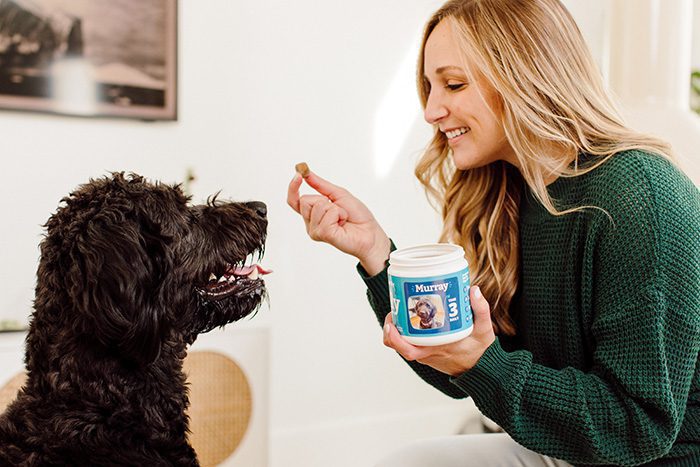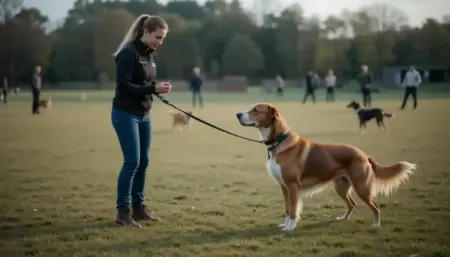The Mexican Hairless Dog, or Xoloitzcuintli, is a breed steeped in history and mystery. For over 3,000 years, this ancient companion has woven itself into the cultural tapestry of Mesoamerica, revered by Aztec and Mayan civilizations not just as a pet, but as a sacred symbol of loyalty and protection.
- Ancient Roots: Depicted in pre-Columbian artifacts and rituals, the Xoloitzcuintli was believed to guide souls through the afterlife, earning its place as a guardian spirit in indigenous folklore.
- Modern Appeal: Today, this affectionate breed thrives as a loyal companion, celebrated for its striking hairless appearance and adaptable temperament. Ideal for families and city dwellers, its sleek, warm skin and minimalist grooming needs make it a practical yet captivating choice.
- Size Variations: Whether you’re drawn to the compact charm of the toy (9–18 lbs), the balanced elegance of the miniature (13–22 lbs), or the commanding presence of the standard (23–30 lbs), there’s a Xolo to suit every lifestyle.
Beyond its exotic aesthetic, the breed’s intelligence and devotion shine, bridging millennia of tradition with contemporary companionship. From Aztec temples to modern homes, the Xoloitzcuintli remains a testament to resilience, culture, and the timeless bond between humans and dogs.
History of the Mexican Hairless Dog
The Mexican Hairless Dog’s story begins not in modern kennels, but amid the pyramids and sacred rituals of ancient Mesoamerica. Revered by the Aztecs as Xoloitzcuintli—a name blending Xolotl, the god of lightning and death, and itzcuintli, meaning “dog”—this breed transcended its role as a mere pet, becoming a bridge between the earthly and the divine.
Mythology and Mortal Realms
- Divine Companionship: According to Aztec cosmology, Xolotl, depicted as a dog-headed deity, was tasked with guiding souls through Mictlán, the underworld. The Xoloitzcuintli mirrored this duty, often buried alongside their owners to accompany them in the afterlife—a practice evidenced by ceramic effigies unearthed in tombs dating back to 1500 BCE.
- Symbol of Renewal: Beyond death rites, the breed’s hairless body and warm skin linked them to fire and rebirth. Some myths claim Xolotl shaped the first Xolo from a sliver of the Bone of Life, infusing it with protective energy.
Healing and Folklore
Lesser-known legends paint the Xolo as a living remedy. Indigenous healers, or curanderos, believed the dog’s radiant body heat could alleviate ailments like arthritis or asthma. Families often slept beside their Xolos, trusting their warmth to ward off evil spirits and physical pain. This practice, documented in colonial-era codices, underscores the breed’s dual role as healer and guardian.
Archaeological Footprints
- Burial Companions: Excavations at sites like Colima and Tlatilco reveal meticulously crafted Xolo figurines nestled among nobility and commoners alike, suggesting their universal cultural value.
- Trade and Tribute: Spanish chronicles note that Xolos were traded as far north as the Southwestern U.S., where they appeared in Pueblo pottery, hinting at a pre-Columbian network of cultural exchange.
From Sacred to Surviving
Despite near extinction post-conquest—Spanish colonizers viewed indigenous rituals as heretical—the Xolo endured. Modern enthusiasts revived the breed in the 20th century, drawing from rural Mexico’s surviving bloodlines. Today, its ancient DNA and striking silhouette remind us of a time when dogs were more than companions: they were cosmic allies.
This rich tapestry of history, myth, and survival cements the Xoloitzcuintli not just as a pet, but as a living relic, carrying whispers of pyres, prayers, and the enduring bond between humans and their oldest allies.
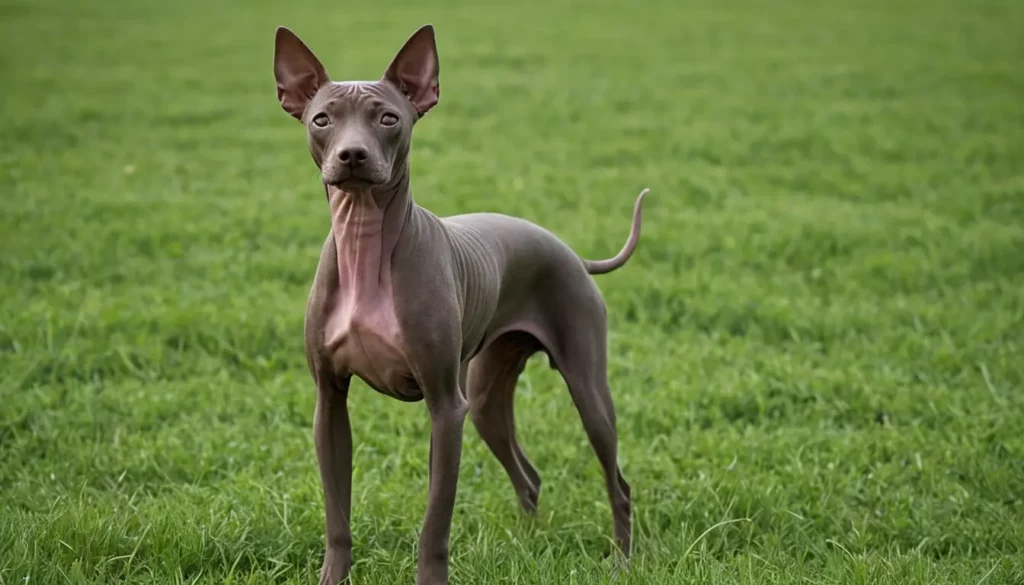
Physical Characteristics: More Than Just Hairless
The Xoloitzcuintli’s striking silhouette is as functional as it is iconic. While its hairlessness defines the breed, a closer look reveals a tapestry of traits shaped by millennia of evolution and adaptation.
Size Variations
- Toy: Weighing 9–18 lbs, this petite variant thrives in cozy urban homes.
- Miniature: At 13–22 lbs, it balances portability with a sturdy presence.
- Standard: The largest, weighing 23–30 lbs, exudes elegance and agility, echoing its ancient role as a guardian.
Skin and Texture
Their smooth, supple skin—often compared to warm suede—belies its resilience. Tough enough to withstand outdoor adventures yet sensitive to extreme temperatures, it requires minimal grooming. Pigmentation varies widely:
- Solid hues: Jet black, slate gray, or rich bronze.
- Patterns: Spotted, mottled, or gradients that mimic twilight skies.
The Coated Counterpart
A lesser-known fact: 1 in 5 Xolos is born with a full coat (short, dense fur). These “powder puffs” retain the breed’s signature almond-shaped eyes and alert expression but offer a surprising twist on tradition.
The Science Behind the Shine
The hairless trait stems from a dominant genetic mutation in the FOXI3 gene, which disrupts hair follicle development. Intriguingly, this mutation also impacts dentition: hairless Xolos often lack premolars or incisors, a quirk termed “Xolo dentition.” While this doesn’t affect their health, it explains their signature underbite and reinforces their status as a living evolutionary puzzle.
Why It Matters
This genetic link isn’t just trivia—it shapes the breed’s care. Owners learn to monitor dental health closely, balancing raw diets or dental chews to support their unique needs.
From their sleek, muscular frames to the subtle sheen of their skin, the Xoloitzcuintli embodies a paradox: ancient yet modern, delicate yet durable. It’s a breed where science and soul meet, wrapped in a package as enigmatic as the cultures that cherished it.
Caring for Your Mexican Hairless Dog’s Skin
The Xoloitzcuintli’s hairless exterior isn’t just a striking feature—it’s a living canvas that demands thoughtful care. Unlike furred breeds, their exposed skin absorbs sunlight, loses heat rapidly, and requires protection akin to caring for human skin. Here’s how to keep your Xolo’s hide healthy and radiant.
Daily Care Essentials
- Sunscreen: Apply dog-safe SPF 30+ lotion on sun-exposed areas (ears, snout, belly) during outdoor adventures. Their lack of fur makes them prone to sunburn, especially in lighter-skinned dogs.
- Moisturize: Use fragrance-free, coconut oil-based balms to combat dryness. Focus on wrinkles and paw pads, where skin can crack. Avoid human products, which may disrupt their pH balance.
- Gentle Cleansing: Bathe weekly with a pH-balanced cleanser to prevent acne and clogged pores. Post-bath, pat dry—never rub—to preserve their skin’s natural oils.
Cold Climates, Warm Hearts
Xolos radiate more body heat than furred breeds, but this also means they lose warmth faster. In chilly weather:
- Layer Up: Opt for soft, breathable sweaters indoors and waterproof coats outdoors.
- Humidify: Combat dry winter air with a humidifier to prevent flakiness.
- Warm Beds: Provide heated mats or fleece-lined beds to retain body heat overnight.
The Genetic Link
The same FOXI3 mutation that causes hairlessness also heightens skin sensitivity. Their pores are larger, making them susceptible to irritation from harsh chemicals or abrasive fabrics. Always rinse thoroughly after walks to remove allergens and pollutants.
A Ritual of Bonding
Skincare isn’t just maintenance—it’s a chance to deepen your connection. Daily massages during moisturizing sessions let you spot irregularities early (like rashes or cysts) while reinforcing trust.
By blending science with tenderness, you’ll ensure your Xolo’s skin remains as resilient and vibrant as the breed itself. After all, a well-cared-for Xolo isn’t just a pet; it’s a testament to 3,000 years of symbiotic survival.
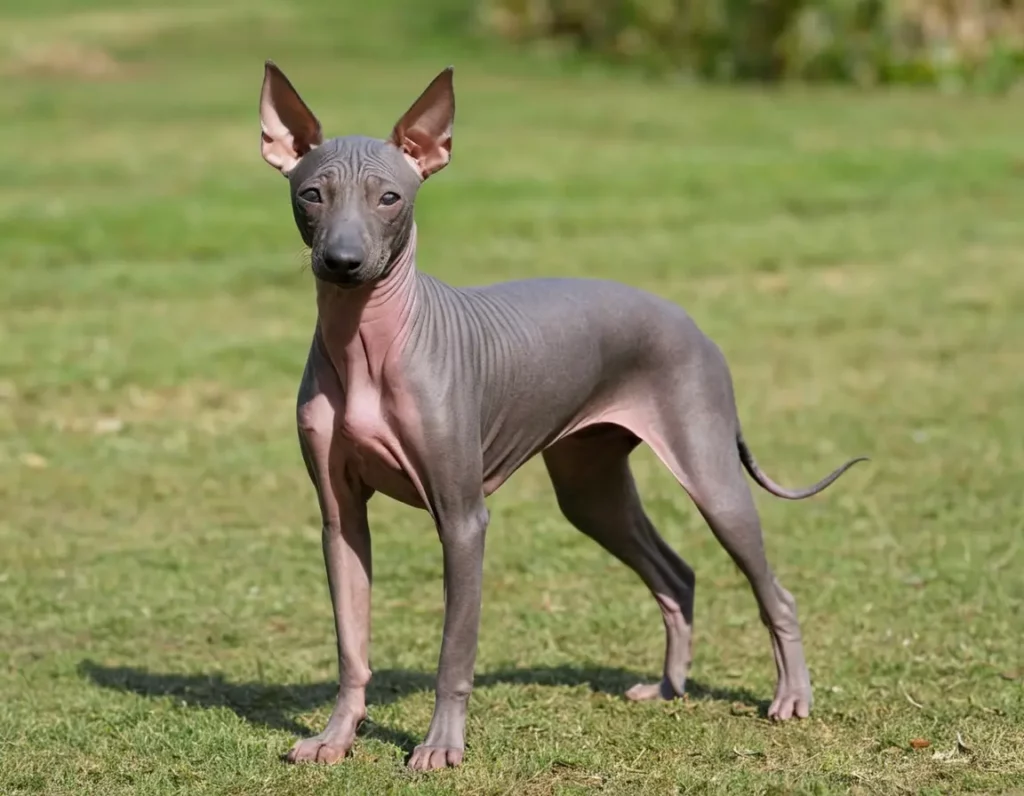
Temperament and Training: Unlocking the Xolo’s Potential
A Breed of Emotional Intelligence
The Mexican Hairless Dog isn’t just intelligent—it’s emotionally astute. Bred for centuries as a guardian and healer, the Xoloitzcuintli combines sharp intuition with a fiercely loyal heart. Their temperament reflects their ancient role: deeply bonded to their family yet discerning with strangers, a trait that once protected Aztec households from intruders.
Core Traits
- Loyalty Beyond Measure: Xolos thrive on companionship, often shadowing their owners from room to room. They’re known to “hug” with their paws or rest their head on a lap, displaying a human-like need for connection.
- Aloofness with Purpose: Reserved around newcomers, they assess strangers cautiously—a survival instinct from their days as protectors. Early socialization transforms wariness into polite curiosity.
- Problem-Solving Prowess: Their intelligence rivals breeds like Border Collies. Left alone too long, they’ll invent games… or dismantle your shoe rack.
Training with Tenderness
Xolos respond best to positive reinforcement—harsh corrections risk fracturing their trust. Their sensitivity isn’t a weakness; it’s a testament to their emotional depth.
Effective Strategies
- Early Socialization: Expose puppies to diverse people, sounds, and environments. Use treats and praise to create positive associations.
- Short, Engaging Sessions: Channel their focus with 10–15 minute bursts of training. Puzzle toys and scent games satisfy their need for mental stimulation.
- Voice and Touch: A calm tone and gentle touch work wonders. They’re attuned to your mood; frustration halts progress, while patience fosters breakthroughs.
The Heart of Sensitivity
Xolos wear their hearts on their skin—literally and metaphorically. Their hairlessness mirrors an emotional transparency: they mirror your energy. A raised voice might send them retreating, while laughter draws them near. This sensitivity stems from their historical role as healers; folklore claims they could sense illness or distress in their owners.
Common Challenges
- Stubborn Streaks: They’ll comply only if you convince them it’s worth their while. Be firm yet fair—think negotiator, not a dictator.
- Guardian Instincts: Barking at unfamiliar noises is instinctual. Redirect this trait with obedience training rather than punishment.
Nurturing the Bond
Training a Xolo isn’t about dominance—it’s a dialogue. Celebrate their quirks, like their habit of “talking” through grunts and whines, and honor their need for dignity. A well-trained Xolo isn’t just obedient; they’re a confident, joyful partner, bridging ancient wisdom with modern life.
In the end, unlocking the Xolo’s potential means embracing their complexity: part philosopher, part comedian, wholly devoted. Their loyalty isn’t given lightly—but once earned, it’s timeless.
Exercise and Activity: Keeping Your Xolo Engaged
Channeling the Ancient Hunter
Beneath the Xoloitzcuintli’s sleek, modern exterior lies the heart of a primitive hunter. Bred to accompany Aztec traders and flush out vermin, their energy is purposeful—not frantic. Today, this translates to a breed that thrives on intelligent exercise: activities that stimulate both body and mind, mirroring the instincts of their ancestors.
Physical Activities
- Agility Training: Their lean, muscular build excels in obstacle courses. Weave poles and jumps tap into their agility, a nod to their history navigating Mesoamerican terrain.
- Hiking Adventures: A Xolo’s endurance shines on trails. Their hairlessness demands sun protection (think lightweight coats), but their curiosity makes them ideal explore companions.
- Fetch with a Twist: Use erratic bouncing balls or flirt poles to mimic prey movement. This not only burns energy but satisfies their instinct to “hunt.”
Mental Stimulation
- Puzzle Toys: Challenge their problem-solving skills with treat-dispensing toys. Start simple, then progress to complex designs—Xolos master these faster than most breeds.
- Scent Work: Hide snacks or toys around the house, encouraging them to “track.” Their acute sense of smell harks back to days of scenting game for their handlers.
- Lure Coursing: For rural owners, this simulated hunt (using a moving lure) channels their prey drive constructively, preventing boredom-related mischief.
The Primitive Instinct Advantage
Xolos possess a hunter’s focus, often fixating on small movements or sounds. Redirect this trait creatively:
- Teach “search” commands for hidden objects, blending obedience with instinct.
- Use tug-of-war to simulate prey capture—let them “win” occasionally to satisfy their drive.
Balancing Act
While energetic, Xolos aren’t marathon runners. Their exercise needs align with their size:
- Toy/Miniature: 30–45 minutes daily of varied activity.
- Standard: Up to an hour, split between vigorous play and downtime.
Avoid midday heat due to their sun-sensitive skin, and never skimp on mental workouts. A bored Xolo may turn to digging, chewing, or outsmarting your trash can.
The Bonding Power of Play
Engaging your Xolo isn’t just about burning energy—it’s about honoring their legacy. When they “stalk” a flirt pole or solve a puzzle, they’re echoing behaviors that once secured survival. Modern games become a language, bridging millennia of instinct with the joy of partnership.
In the end, a well-exercised Xolo is a serene companion: calm, content, and ready to curl up beside you, their ancient soul at peace in a modern world.

Grooming the Mexican Hairless Dog: A Unique Routine
Beyond the Brush: Caring for Living Art
Grooming a Mexican Hairless Dog isn’t about detangling fur—it’s a ritual of preservation. Their naked skin, warm to the touch, demands a routine as thoughtful as the breed’s ancient lineage. From managing natural oils to protecting their delicate smiles, here’s how to honor their uniqueness.
Daily Essentials
- Skin Wiping: Use a soft, damp cloth to gently remove dirt and excess oil from wrinkles and folds. This prevents acne, especially around the neck and legs.
- Dental Checks: Inspect gums and remaining teeth (many Xolos lack premolars). Wipe teeth with enzymatic dog toothpaste to combat plaque, a legacy of their genetic mutation.
Weekly Routines
- Bathing: Once a week, bathe with a pH-balanced, oatmeal-based cleanser to avoid stripping natural oils. Rinse thoroughly—residue can clog pores.
- Moisturizing: Apply coconut or shea butter balms post-bath to lock in hydration. Focus on elbows, knees, and paw pads, which tend to dry faster.
- Ear Care: Clean ears with vet-approved wipes to prevent infections in their upright, exposed ear canals.
Seasonal Adjustments
- Winter Care: Cold air dehydrates their skin. Increase moisturizing sessions to every other day and use a humidifier indoors. Opt for doggy sweaters to reduce chafing from heated homes.
- Summer Prep: Apply SPF 30+ dog sunscreen 20 minutes before sun exposure, reapplying every 2–3 hours. Avoid midday walks to prevent burns on sensitive pink skin.
The Genetic Link to Dental Care
The FOXI3 mutation responsible for hairlessness also affects tooth development. Missing teeth aren’t a flaw—they’re a genetic signature. Support their dental health with:
- Raw Diets: Crunchy bones or dental chews (if teeth permit) to scrape tartar.
- Annual Vet Visits: Early detection of abscesses or gum disease, common in tooth-compromised breeds.
The Art of Connection
Grooming a Xolo isn’t a chore—it’s a dialogue. Their skin, responsive to touch, becomes a map of trust. A weekly massage calms nerves and strengthens your bond, echoing the breed’s history as healers.
Intending to their needs, you’re not just caring for a pet—you’re preserving a living artifact. Each wipe, each balm, is a nod to the Aztec reverence for this breed: resilient, sacred, and utterly irreplaceable.
Nutrition: Feeding Your Xolo for Optimal Health
Mexican Hairless Dog Diet
The Xoloitzcuintli’s dietary needs are as unique as its history. Centuries ago, Aztec caretakers fed these dogs a diet rich in maize, beans, and occasional small game—a reflection of Mesoamerican agriculture. Today, while their meals look different, the principles of balance and intentionality remain.
Modern Dietary Foundations
- Omega Fatty Acids: Vital for skin health, given their lack of fur. Incorporate wild-caught salmon, flaxseeds, or fish oil supplements to combat dryness and inflammation.
- High-Quality Proteins: Prioritize lean meats like turkey, chicken, or bison. Their muscular build thrives on diets mirroring the protein-rich prey their ancestors hunted.
- Calcium and Phosphorus: Counteract dental irregularities with bone broth, cooked bones (if tooth structure allows), or vet-approved supplements.
Historical Wisdom, Modern Twists
Ancient Xolos were often fed nixtamalized corn (alkaline-treated maize), a practice that unlocked nutrients and aided digestion. Today, this translates to:
- Whole Foods: Opt for grain-inclusive diets with cooked quinoa or brown rice for fiber, paired with ancestral ingredients like squash and chia seeds.
- Limited Fillers: Avoid corn or soy-heavy commercial foods—a nod to their historical diet’s simplicity.
Feeding Rituals
- Portion Control: Split meals into two daily servings to prevent bloat. Adjust portions seasonally—Xolos may eat less in the summer heat.
- Hydration: Always provide fresh water. Their higher body heat increases susceptibility to dehydration, especially during play.
Dental Considerations
Missing teeth doesn’t mean compromised nutrition. Serve softened kibble, raw minced meat, or moisture-rich veggies like steamed carrots. Avoid overly hard treats that strain fragile gums.
A Recipe for Connection
Preparing meals for your Xolo can mirror the reverence of their past. Some owners craft homemade diets inspired by Aztec staples:
- Sample Bowl: Shredded chicken (cooked plain), mashed sweet potato, spinach, and a dash of chia seeds.
- Treats: Freeze-dried liver or dehydrated pumpkin slices for training rewards.
In nourishing your Xolo, you’re not just feeding a pet—you’re sustaining a lineage that’s survived on resilience and adaptability. Their diet, like their story, is a blend of old and new, crafted to honor both their origins and their vibrant present.
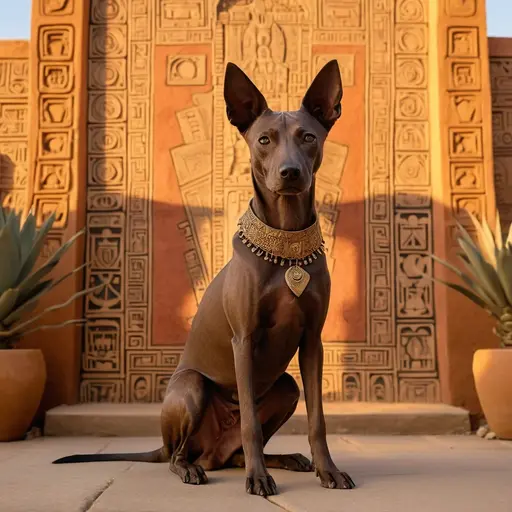
Health Considerations: Beyond the Skin
Mexican Hairless Dog Health: A Legacy of Resilience
The Xoloitzcuintli’s lifespan—often stretching 12–15 years—is a testament to its hardy genetics. Yet, their ancient vigor requires modern care to thrive. While their hairlessness and unique biology present specific health considerations, proactive stewardship ensures these dogs live not just long, but vibrantly.
Skin Health: Beyond the Surface
- Acne and Irritation: Their oil-producing glands can clog, especially in wrinkles. Combat this with gentle, pH-balanced cleansers and weekly exfoliation using a soft brush.
- Environmental Sensitivity: Extreme temperatures and allergens (pollen, dust) may trigger rashes. Use hypoallergenic bedding and rinse paws after walks.
- Lumps and Cysts: Regularly inspect their skin; sebaceous cysts are common but usually harmless. Report changes to your vet promptly.
Dental Vigilance
- Missing Teeth: Up to 30% of Xolos are born without premolars or incisors. Monitor remaining teeth for decay, and offer dental chews if feasible.
- Gum Health: Brush gums gently with vet-approved toothpaste to prevent periodontal disease, which can shorten their lifespan if untreated.
Allergy Awareness
While hypoallergenic for many, Xolos can provoke reactions in sensitive individuals due to skin oils. Manage this by:
- Bathing weekly to reduce oil buildup.
- Using air purifiers to minimize dander spread.
The Longevity Blueprint
A Xolo’s lifespan hinges on preventive care:
- Annual Exams: Bloodwork and dental checks catch issues early.
- Weight Management: Lean bodies reduce stress on joints and organs.
- Mental Wellness: Stimulation through play and companionship combats cognitive decline in older dogs.
A Pact Across Millennia
The Xolo’s endurance—from Aztec temples to modern homes—stems from a partnership rooted in care. Their health challenges aren’t flaws but reminders of their ancient blueprint. By addressing their needs with intentionality, you honor a lineage that’s survived for 3,000 years.
In return, they offer a gift rare in the canine world: a decade (or two) of loyalty, warmth, and the quiet wisdom of a breed that’s mastered the art of survival.
The Mexican Hairless Dog in Modern Culture
From Ancient Icon to Modern Muse
The Xoloitzcuintli’s journey from Aztec mythology to 21st-century pop culture is a testament to its enduring mystique. More than a pet, it’s a living symbol of Mexican identity—a bridge between ancestral reverence and contemporary creativity.
Art and Symbolism
- Cultural Revival: Modern Mexican artists, like muralists in Oaxaca, depict Xolos alongside pre-Hispanic motifs, celebrating their role as guardians of heritage.
- Global Galleries: The breed’s sleek silhouette has inspired sculptures and paintings worldwide, notably in Frida Kahlo’s works, where Xolos symbolized resilience and primal energy.
- Fashion Statements: Designers feature the Xolo in haute couture, its hairless form evoking futuristic elegance at events like Mexico City Fashion Week.
Film and Media
- Animated Pride: Pixar’s Coco featured a Xolo named Dante, introducing the breed to millions as a loyal guide through the afterlife—a nod to its spiritual legacy.
- Documentaries: Films like Xolo: The Sacred Dog explore its cultural resurrection, tracing its path from near-extinction to national pride.
Advocacy and Acceptance
Despite their gentle nature, Xolos face breed-specific stereotypes due to their stark appearance. Advocates leverage their cultural significance to challenge bans:
- Legal Battles: Organizations cite the Xolo’s historical role in Mexican rituals to argue against discriminatory legislation.
- PR Campaigns: Social media showcases them as therapy dogs-in-training, countering fears with images of their calm, affectionate interactions.
The Untapped Therapy Potential
Xolos possesses traits ideal for emotional support:
- Natural Healers: Their radiant body heat (up to 104°F) soothes chronic pain sufferers, echoing ancient beliefs in their restorative powers.
- Calm Demeanor: Unlike high-energy breeds, Xolos adapt well to hospitals or schools, offering quiet companionship.
- Conversation Starters: Their unique look sparks dialogue, helping therapists break the ice with patients.
A Cultural Ambassador
The Xoloitzcuintli’s modern renaissance reflects a broader truth: it’s more than a dog. It’s a diplomat of Mexican heritage, a muse for artists, and a pioneer in redefining breed perceptions. Whether starring in films, comforting a patient, or posing in galleries, the Xolo carries forward a 3,000-year legacy—one that insists ancient wisdom still has a place in our modern world.
Conclusion
The Mexican Hairless Dog, or Xoloitzcuintli, is more than a breed—it’s a living chronicle of resilience. From its origins as a sacred companion to Aztec warriors and spiritual guides for souls traversing Mictlán, to its modern role as a therapy dog and cultural ambassador, the Xolo weaves the past and present into a singular narrative. Its hairless form, warm to the touch, carries the echoes of ancient fires and the promise of unwavering loyalty.
This breed’s journey is a testament to survival: surviving conquest, near-extinction, and modern misconceptions. Yet, in homes today, Xolos thrive as affectionate guardians, their intelligence and sensitivity forging bonds deeper than fur ever could. They challenge us to rethink beauty, to embrace the unconventional, and to honor the stories etched into their DNA.
For those lucky enough to share their lives with an Xolo, the experience is transformative. They are not just pets but partners—philosophers with playful streaks, healers with mischievous grins, and quiet reminders of the cultures that revered them.
Share Your Story
If a Xoloitzcuintli has touched your life, we invite you to join the chorus of owners worldwide. Share your tales of midnight cuddles, stubborn antics, or the way their skin radiates warmth like a living hearth. Together, we celebrate a breed that is as enigmatic as it is enduring.
The Mexican Hairless Dog offers a blend of history, beauty, and loyalty unlike any other breed—a relic reborn, a companion for the ages. In their sleek silhouette, we find a story 3,000 years in the making, and a future brimming with possibility.






